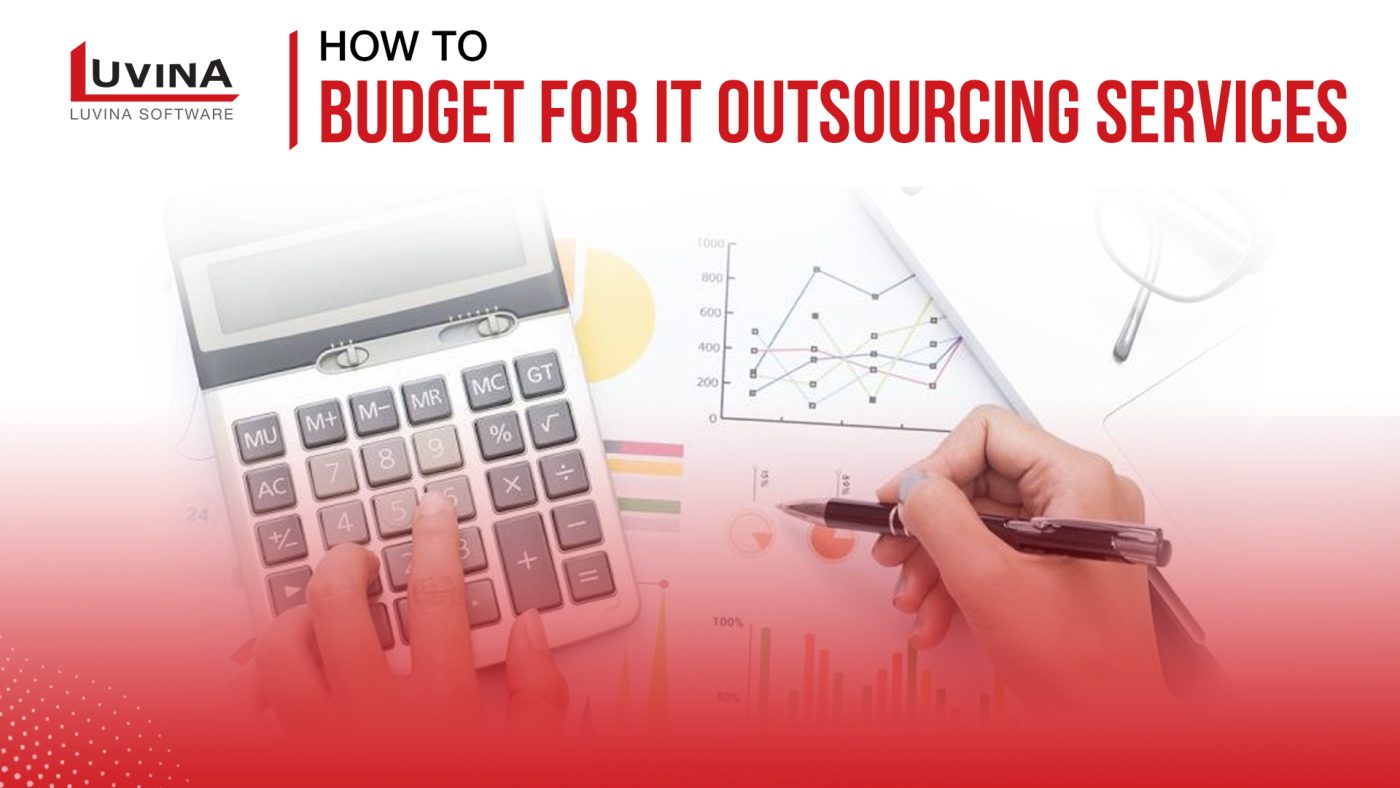Optimizing IT outsourcing costs will help you save significantly on operational expenses while still achieving goals in business. In this article, we will guide you through detailed steps in optimizing outsourcing IT services costs to help you achieve your desired outcomes.
In today’s fast-paced and technologically advanced world, IT outsourcing services have become an increasingly popular choice for businesses looking to enhance their operational efficiency and reduce costs.

However, it is crucial for businesses to effectively budget, to get the maximum benefits of IT outsourcing from these services. In this article, we will provide you with a comprehensive guide on how to budget for IT outsourcing services, to help you make informed decisions and achieve your desired outcomes.
Types of Cost in IT Outsourcing Costs
Depending on the specific requests of the companies, each IT outsourcing projects will cover different costs. These are the most common costs induced in a standard project:
Remote Monitoring
These costs typically include expenses for monitoring tools, infrastructure, and a dedicated professional IT team to ensure the system remains secure and operational around the clock.
The extent of automation, number of devices needed, and required responses time can be contributing factors to the formation of remote monitoring cost.
Help desk
Help desk costs in IT outsourcing often varies based on service level agreements (SLAs), the number of users supported, the sophistication of issues, or the amount of time operating.
Server management
This cost depends on the size and complexity of the server infrastructure, the level of monitoring efforts required, and the type of support, such as patching, backups, or security management.
Basic cybersecurity measures
Most IT services providers commit to ensure fundamental cybersecurity measures to put a restraint on data breaches, phishing attacks or malware infections for their clients. The effort, time utilized to accomplish these processes will then turn into the amount of costs in the IT outsourcing project.
Software updates
Every software needs frequent updates, upgrading becomes a crucial aspects of IT outsourcing, but they can also introduce additional costs. Depending on the complexity of the updates, the frequency, the outsourcing providers will charge you different range of future software updates costs. It is of paramount importance to clarify these costs upfront to constraint unanticipated expenses and ensure a seamless transition to new software versions.
24/7 Support
For numerous projects, outsourced team needs to keep the software operational around-the-clock to mitigate the risks of bottlenecks or downtime, even during holidays or days off. Therefore, these IT workers have to work overtime or in shifts. This gives rise to additional costs.
The payment models and the average cost of outsourcing IT services
When considering IT outsourcing costs, understanding the payment models and average cost of outsourcing IT is essential for effective budgeting and decision-making. IT outsourcing service providers typically offer various payment models to accommodate different client needs.
1. Flat-rate, all-inclusive payment model
The Flat-rate, all-inclusive model is one of the most popular payment models IT service providers use. Under this model, IT companies typically charge a monthly fee ranging from $110 to $200 per user. Providers offering managed IT services with advanced line-of-business applications and customer-facing solutions often have higher pricing structures.
However, the cost of a managed service provider (MSP) reflects the level of support and resources they can offer your business. So opting for a higher-priced MSP increases the likelihood of obtaining the necessary assistance and operational efficiency.

2. The hourly or usage-based payment model
Another commonly used payment model is the hourly or usage-based model. In this model, the client pays for the actual time spent by the service provider on the project. The costs are calculated based on hourly rates or usage. This model offers flexibility, especially when the project scope is not fully defined or subject to frequent changes.
Factors affecting IT outsourcing costs
Several factors play a significant role in affecting the outsourcing of IT services. Understanding these factors is crucial for businesses to optimize their outsourcing arrangements.
1. The diversity of services of IT outsourcing providers
The broader range of services offered by the IT outsourcing provider, the higher it costs. This is because the IT outsourcing provider is offering a more extensive and comprehensive set of services, which requires additional resources, expertise, and capabilities.
2. Operational maturity level (OML) and reputation of IT service providers
Outsourced IT support costs are closely linked to the operational maturity level (OML) of the provider. The price charged by an IT service provider reflects the effectiveness of their business operations, and providers offering low-cost fees may likely deliver lower-quality services. A more affordable outsourced IT services provider often lacks the robust back-end processes required for operational stability and long-term success.
3. Security measures and quality assurance processes of IT service providers
IT service providers are increasingly integrating cybersecurity elements into their outsourced IT solutions. Opting for comprehensive IT outsourcing that includes advanced security services will result in higher costs, typically reaching the upper end of the price range, around $200 per user per month.
Your outsourced IT service provider should help your business reduce unwanted IT costs, provide the best equivalent services for the service fee, and evaluate service performance. If your outsourced IT service provider fails to meet these requirements, you may be paying too much for too little benefit.
How to budget for IT outsourcing services effectively
Businesses often believe that they do not have enough budget that meet the outsourcing IT services cost. However, in reality, outsourcing IT services can save a significant amount of costs compared to employing an in-house IT team.

What would happen if your internal IT is on sick leave, or if your company lacked the necessary resources from IT service providers? The damage that your business would incur would be much greater than the cost of outsourcing IT.
Therefore, instead of trying to save money by not outsourcing, it is advisable to develop a reasonable budget plan for outsourcing IT based on the following suggestions.
1. Define your IT outsourcing goal
Before allocating a budget for IT outsourcing services, it is important to clearly define your goals and objectives. Determine the specific IT functions or processes you wish to outsource and the desired outcomes you expect to achieve. Whether it is software development, infrastructure management, or customer support, having a clear understanding of your goals will help you allocate resources more effectively.
2. Determining the scope, timetable, and expectations when using outsourced IT service
Determining the scope and necessary time for hiring an IT outsourcing not only helps you estimate the required resources but also allows you to evaluate performance at each stage. Additionally, it is crucial to have a clear understanding of your business expectations when using outsourced IT services, such as improving efficiency, cost savings, etc,… This will help you establish clear objectives and balance the necessary resources and budget accordingly.
3. Negotiating contracts and payment terms after determining the cost of outsourcing IT
When negotiating contracts and payment terms with an IT outsourcing service provider, it is important to define the scope of the contract, determine the payment method, and reach an agreement on payment conditions and timing. Additionally, you should pay attention to the IT outsourcing costs, including the base service fees, and additional charges.

Ensuring that the controls within the contract are clear and detailed is crucial, including clearly defining the rights and responsibilities of both parties. Clear negotiations of the contract and payment terms will help you optimize your budget and establish a sustainable partnership with the outsourced IT outsourcing service provider.
4. Monitoring and evaluating the performance of IT outsourcing service providers
Budgeting is an ongoing process that requires continuous monitoring and evaluation. Keep track of your IT outsourcing costs and regularly assess the value you are receiving from the service provider. Conduct periodic reviews to identify any cost-saving opportunities or areas where the budget can be optimized.
Leave your information so we can send you this document directly to your email!
Optimize outsourcing IT services cost
In conclusion, budgeting for IT outsourcing services requires careful planning, thorough research, and a focus on both cost-effectiveness and quality. With proper budgeting, you can harness the potential of IT outsourcing to drive business growth.
Hope this article has provided you with valuable knowledge to optimize your IT outsourcing budget. If you are seeking an outsourced IT company or have any inquiries regarding IT outsourcing costs, please contact Luvina for professional advice.
>> See more: Right Team Size for Your Software Development Outsourcing Project









Read More From Us?
Sign up for our newsletter
Read More From Us?
Sign up for our newsletter